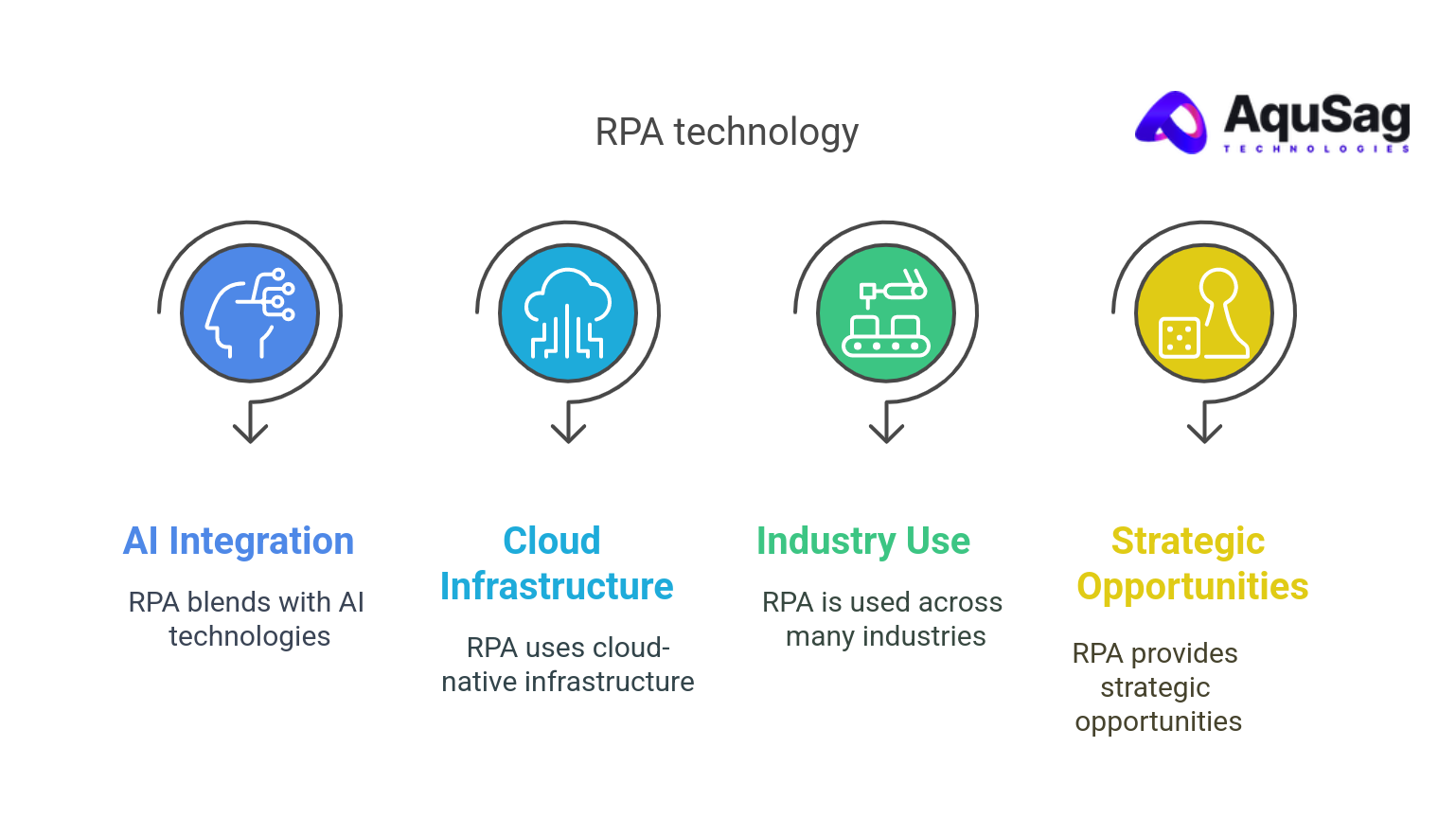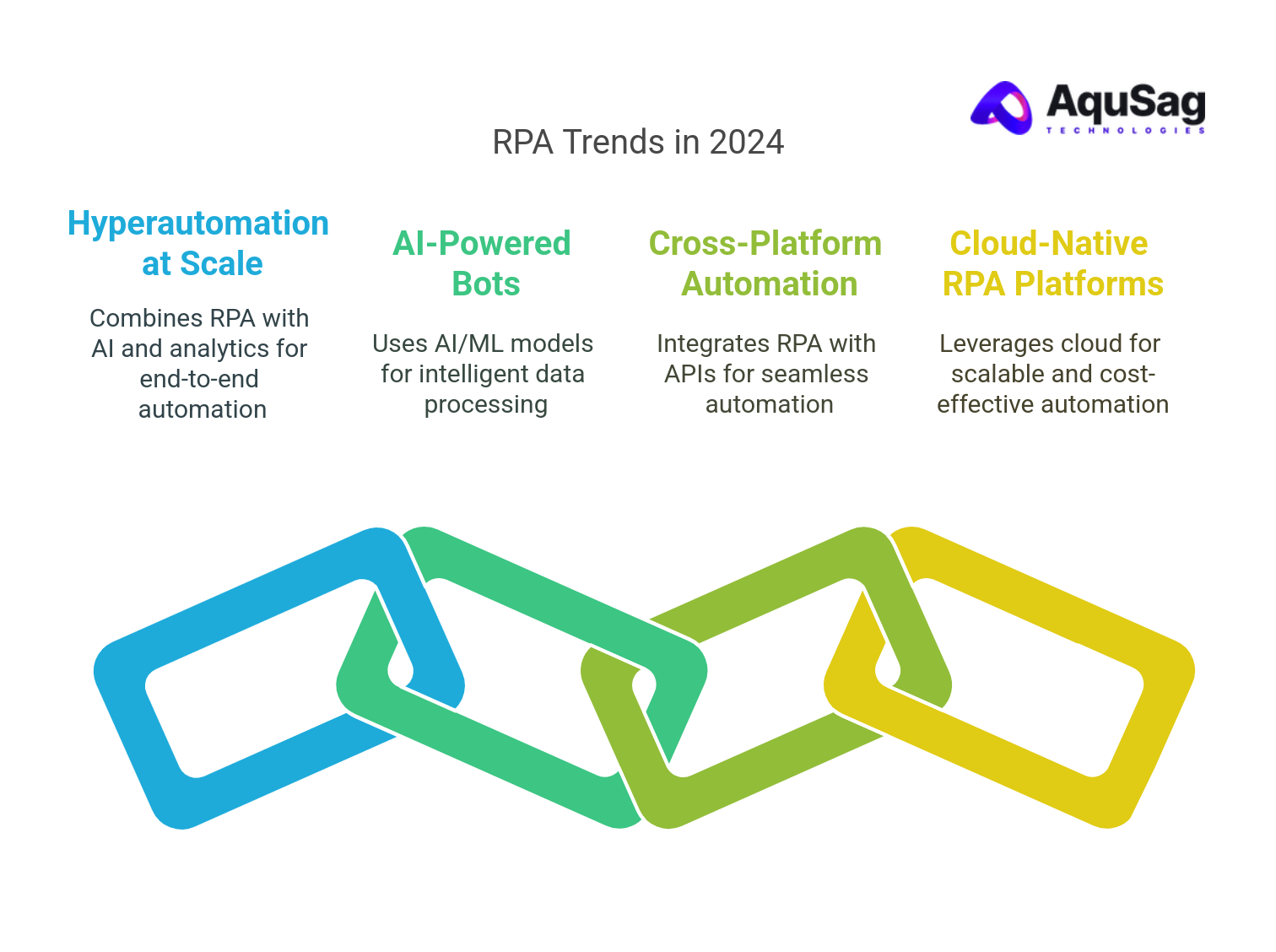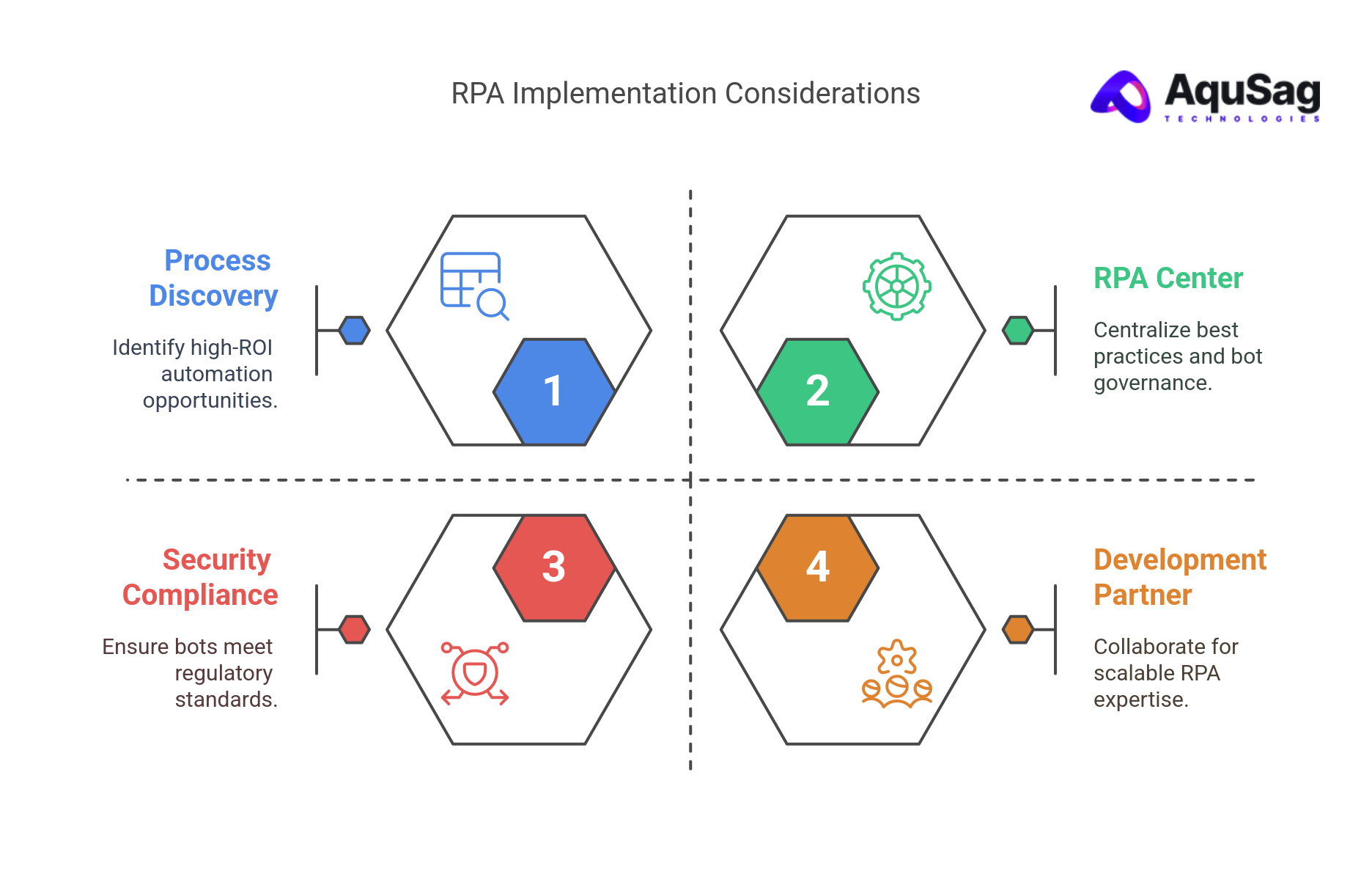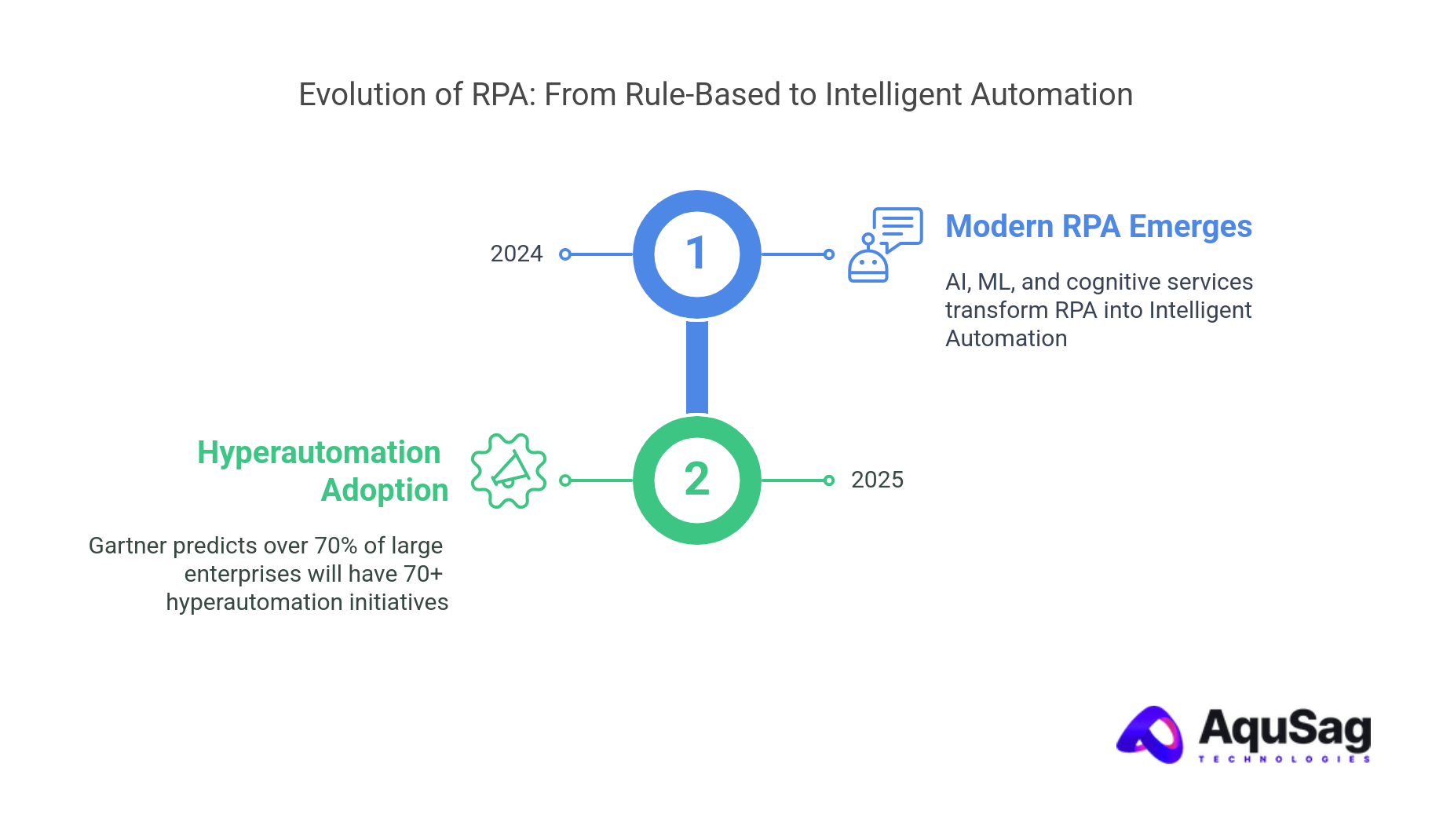 In the race toward digital transformation, Robotic Process Automation (RPA) continues to stand out as a foundational technology for businesses aiming to streamline operations, improve efficiency, and reduce costs. As we move through 2024, RPA is no longer confined to simple rule-based tasks—it is evolving into an intelligent, AI-powered automation ecosystem that supports enterprise-wide innovation.
In the race toward digital transformation, Robotic Process Automation (RPA) continues to stand out as a foundational technology for businesses aiming to streamline operations, improve efficiency, and reduce costs. As we move through 2024, RPA is no longer confined to simple rule-based tasks—it is evolving into an intelligent, AI-powered automation ecosystem that supports enterprise-wide innovation.
This year marks a turning point, with RPA blending seamlessly with AI, machine learning (ML), natural language processing (NLP), and cloud-native infrastructure to enable intelligent decision-making and hyperautomation. For industries such as healthcare, logistics, eClinical, software development, manufacturing, blockchain, and AI/ML, the stakes are higher than ever. The need for scale, speed, and accuracy is pushing CTOs and innovation heads to rethink automation strategies.
This blog explores the latest RPA trends, innovations, industry use cases, and strategic opportunities for forward-thinking organizations. We’ll also examine how AquSag Technologies can help you ride the next wave of digital transformation with robust RPA solutions.
1. The Evolution of RPA: From Rule-Based Scripts to Intelligent Automation
Legacy RPA vs. Modern RPA
Traditional RPA focused on automating repetitive, rule-based tasks like data entry, form processing, and back-office transactions. While effective in reducing manual workload, these systems lacked adaptability.
In 2024, modern RPA solutions integrate AI, ML, and cognitive services, enabling automation systems to handle complex decision-making, understand context, and continuously learn. This shift towards Intelligent Automation (IA) or Hyperautomation is revolutionizing enterprise workflows.
Gartner predicts that by 2025, over 70% of large global enterprises will have over 70 concurrent hyperautomation initiatives in place.
— Gartner, “Top Strategic Technology Trends for 2024”
Key Advancements Driving RPA Forward
- Cognitive AI Capabilities: Natural Language Understanding (NLU), sentiment analysis, and image recognition expand what RPA bots can do.
- Cloud-Native Automation: Scalability and agility are being prioritized via cloud deployment, enabling distributed teams to orchestrate bots globally.
- Citizen Development Platforms: Low-code and no-code environments are democratizing automation, enabling business users to build and deploy bots.
- Process Discovery Tools: AI-driven tools analyze workflows and identify high-ROI automation opportunities automatically.
Featured Blog Post: The Future of Natural Language Processing (NLP) in Customer Service
2. Key RPA Trends to Watch in 2024
Trend #1: Hyperautomation at Scale
Hyperautomation combines RPA with AI, process mining, analytics, and iPaaS (Integration Platform as a Service) to automate end-to-end business processes. Organizations now adopt hyperautomation as a strategic pillar—not just for cost-cutting but also for innovation.
Example: In the healthcare sector, hyperautomation is helping hospitals automate patient intake, insurance verification, and diagnostics coordination—improving both compliance and patient satisfaction.
Trend #2: AI-Powered Bots
In 2024, RPA bots are becoming "thinking assistants" that interpret unstructured data, infer context, and trigger workflows dynamically.
- AI/ML models are embedded within bots to adapt based on feedback loops.
- Intelligent Document Processing (IDP) is allowing bots to extract data from handwritten forms, scanned documents, or voice input.
Case Study: A logistics firm deployed AI-powered RPA bots to analyze bills of lading, invoices, and shipment documents—reducing processing time by 60% and minimizing human error.
Trend #3: Cross-Platform Automation with API Integration
As APIs become standard across enterprise applications, RPA platforms are evolving to work seamlessly with API-based automation rather than relying only on UI scraping. This hybrid model reduces breakage and increases reliability.
Sectors Leading This Trend:
- Software and blockchain platforms adopting DevOps pipelines benefit immensely from cross-system automation.
- Manufacturing systems integrating with IoT platforms use RPA to respond to sensor-driven triggers.
Trend #4: Cloud-Native RPA Platforms
Cloud-native platforms allow organizations to scale their automation infrastructure quickly, reduce upfront costs, and support remote or hybrid workforces. Leading vendors now offer SaaS-based RPA orchestration, enabling real-time monitoring and updates.
By 2024, over 60% of RPA deployments are expected to be cloud-native, accelerating enterprise agility and DevSecOps integration.
— Forrester, 2023 Automation Trends Report
 3. Industry Use Cases: RPA in Action
3. Industry Use Cases: RPA in Action
Healthcare and eClinical
RPA is transforming patient care, revenue cycle management, and clinical trial operations.
- Patient Onboarding: Automating intake, insurance validation, and EHR updates.
- Claims Processing: Bots extract and validate claim data to improve turnaround time.
- Clinical Data Management: eClinical systems leverage RPA for trial data aggregation, regulatory compliance, and reporting.
Example: A leading eClinical firm used RPA to automate clinical protocol submissions to regulatory bodies, cutting processing time by 40%.
Manufacturing and Smart Factories
RPA plays a pivotal role in smart factory ecosystems, working alongside AI and IoT.
- Order Management: Automation ensures orders are validated, processed, and routed correctly.
- Predictive Maintenance: RPA triggers actions based on sensor alerts and ML forecasts.
- Supply Chain Coordination: Automates vendor communications, invoice generation, and shipment tracking.
Logistics and Supply Chain
Speed and accuracy define logistics success—and RPA delivers both.
- Shipment Scheduling: RPA automates coordination between carriers, warehouses, and customers.
- Invoice Reconciliation: Bots match purchase orders with invoices and flag anomalies.
- Inventory Management: Integration with WMS and ERP ensures up-to-date records.
Software, Blockchain, and AI/ML
For companies building platforms in AI or blockchain, RPA accelerates both backend and customer-facing operations.
- DevOps Automation: Bots manage release pipelines, test automation, and deployment checks.
- Blockchain Transaction Monitoring: RPA audits ledger entries, flags anomalies, and triggers compliance workflows.
- ML Data Preparation: Bots clean, tag, and migrate large datasets for model training.
4. The Convergence of RPA and Generative AI
Generative AI tools like GPT models are now complementing RPA bots to handle tasks that involve creativity, reasoning, and unstructured input.
Conversational Automation
- Voice assistants and chatbots powered by GenAI are being integrated into RPA workflows for customer support and internal helpdesks.
- Instead of routing structured queries, bots can now interpret free-form input and respond intelligently.
Document Generation
- RPA + GenAI is used to draft legal documents, business reports, or compliance summaries, with bots pulling relevant data and AI generating polished outputs.
Example: A financial services firm used RPA and GPT-based models to automate investor report generation—saving hundreds of hours each quarter.
Featured Blog Post: How AI and ML are Revolutionizing Business Processes: A Deep Dive
5. Strategic Considerations for CTOs and Innovation Leaders
Implementing RPA at scale requires more than tools—it demands vision, architecture, and governance. Here's what decision-makers must consider in 2024:
Process Discovery and Prioritization
Use AI-powered process mining tools to identify automation opportunities that deliver the highest ROI. Focus on high-volume, error-prone processes first.
RPA Center of Excellence (CoE)
Establish a centralized CoE to define best practices, standardize frameworks, and govern bot performance across teams and departments.
Security and Compliance
- Ensure bots are compliant with HIPAA, GDPR, and industry-specific regulations.
- Adopt identity and access controls, encrypted credentials, and audit trails.
Partner with the Right Development Team
Scalable RPA demands scalable expertise. Collaborating with a dedicated RPA development partner like AquSag Technologies ensures seamless execution, whether you're piloting automation or deploying across global operations.
 6. Measuring ROI and Business Impact
6. Measuring ROI and Business Impact
| Metric | Pre-RPA Baseline | Post-RPA Impact |
|---|---|---|
| Transaction Processing Time | 3–4 hours | Under 30 minutes |
| Human Error Rate | 8–10% | Less than 1% |
| Operational Cost per Task | $5–7 | <$1 |
| FTE Resources Reallocated | 0 | 10–30 per project |
Companies that scale RPA across multiple business units report 3–5x ROI within the first 12–18 months of deployment.
7. AquSag Technologies: Your Partner in Next-Gen Automation
At AquSag Technologies, we specialize in building and scaling RPA solutions that integrate seamlessly with enterprise systems, AI platforms, and modern cloud architectures. Our team of RPA experts and AI engineers help organizations:
- Identify automation opportunities through AI-driven process mapping
- Develop scalable bots using UiPath, Automation Anywhere, and open-source stacks
- Integrate RPA with ERP, CRM, EHR, and cloud-native tools
- Build governance frameworks to manage compliance and security
- Support continuous improvement via analytics and feedback loops
Whether you're in healthcare, software, logistics, manufacturing, or AI/ML, we offer the dedicated development teams, consulting services, and strategic guidance needed to innovate with confidence.
8. Final Thoughts: Automation Isn’t the Future—It’s the Now
In 2024, RPA is no longer optional—it's imperative. Businesses that fail to embrace intelligent automation risk falling behind in a competitive, data-driven world. Those that act now, however, stand to unlock unparalleled operational agility, cost efficiency, and customer satisfaction.
The convergence of RPA with AI, ML, and cloud is rewriting the automation playbook. For decision-makers across industries, the opportunity is clear: Automate smarter. Scale faster. Innovate deeper.
Ready to Embrace the Future of RPA?
Whether you're exploring RPA for the first time or looking to scale existing deployments, AquSag Technologies can help you turn automation into a strategic advantage.
Contact us today to discuss your automation goals, assess your current processes, or augment your team with our RPA and AI specialists.


